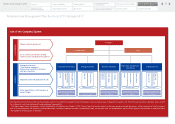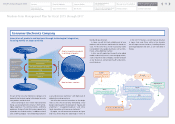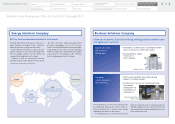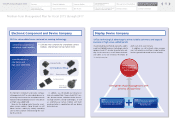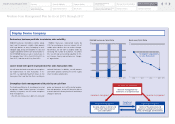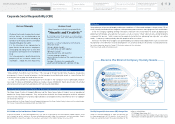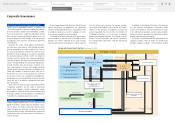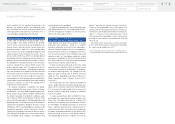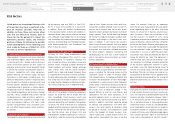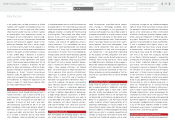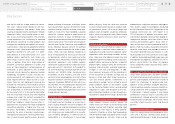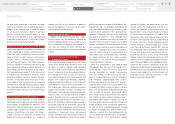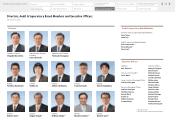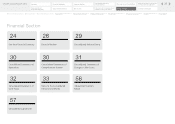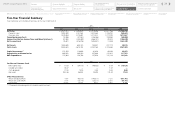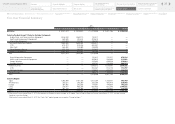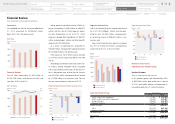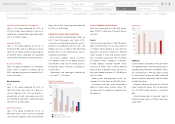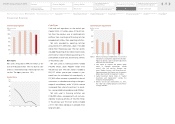Sharp 2015 Annual Report Download - page 20
Download and view the complete annual report
Please find page 20 of the 2015 Sharp annual report below. You can navigate through the pages in the report by either clicking on the pages listed below, or by using the keyword search tool below to find specific information within the annual report.
Listed below are the principal business risks
of Sharp that may have a significant influ-
ence on investors’ decisions. Note that in
addition to these, there exist certain other
risks that are difficult to foresee. Each of
these risks has the potential to impact the
operations, business results, and financial
position of Sharp. All references to possible
future developments in the following text
were made by Sharp as of March 31, 2015
(or June 23, 2015 as appropriate).
(1) Global Market Trends and Overseas Businesses
Sharp conducts its business not only in Japan but
also in different regions around the world, mainly
in countries of the U.S., Europe, and Asia. Business
results and financial position are thus subject to
economic and consumer trends (especially trends
in private consumption and corporate capital in-
vestment), competition with other companies,
product demand, raw material supply, and price
fluctuations in each region, including Japan. The
political and economic situation in respective areas
may also exert an influence on business results and
financial position. Moreover, difficulty in monitor-
ing and adjusting its operations in various regions;
the growing impact of world economic recession;
risks related to regulations and taxation in foreign
countries; various standards and customs related
to doing business; trade restrictions; political in-
stability and business uncertainty; changes in po-
litical and economic relations with Japan; social
turmoil; rising personnel costs; and labor issues,
etc. may affect Sharp’s business results and finan-
cial position.
(2) Exchange Rate Fluctuations
The proportion of consolidated net sales accounted
for by overseas sales was 59.4% in fiscal 2012,
60.7% in fiscal 2013, and 65.2% in fiscal 2014.
In addition, Sharp sells products made overseas
in the Japanese market, and also sells products in
countries where it does not manufacture the prod-
ucts. Although Sharp hedges the risk of exchange
rate fluctuations by employing forward exchange
contracts and expanding and strengthening opti-
mally located production, such fluctuations may
affect its business results.
(3) Medium-Term Management Plan
On May 14, 2015, Sharp announced its new
Medium-Term Management Plan, which it is now
working diligently to implement. However, the
plan is based on various assumptions concerning
external factors, including customer demand for
Sharp’s products and services, foreign exchange
rates, interest rates, and the overall economic
growth rate in Japan and abroad. Moreover, there
is no guarantee that business initiatives outlined in
the plan will be executed. Accordingly, it is possible
that Sharp may not be able to achieve its targets
set under the plan. Moreover, enforcement of busi-
ness restructuring may result in additional losses.
(4) Dependence on Certain Products and Clients
Sales of LCDs and digital information equipment
account for more than half of Sharp’s total net
sales. Accordingly, Sharp’s business results may
be impacted due to reasons including a decline in
customer demand for such products, falling prod-
uct prices, the arrival of alternative or competing
products of other companies, and intensified com-
petition stemming from the entry of new compa-
nies into the market. Sales of Sharp’s LCDs and
mobile phones are dominated by only a small num-
ber of clients, who thus account for a considerable
share of sales. Sharp’s business results and finan-
cial position could be affected if sales to such im-
portant clients languish due not to only factors
related to Sharp’s products but reasons outside of
Sharp’s control. These include declining demand
for the clients’ products, changes in product speci-
fications, and changes in the clients’ sales strat-
egies. In addition, if such clients have concerns
about Sharp’s financial position, they may reduce
the scale of transactions with Sharp, and prioritize
transactions with their own affiliated companies
for certain products. Moreover, maintaining and
developing business with such a small number of
clients may lead to various limitations on Sharp’s
business operations.
(5) Strategic Alliances and Collaborations
Sharp implements strategic alliances and collabo-
rations as well as capital alliances with other com-
panies—including the Samsung Group and the
Qualcomm Group—in order to enhance corpo-
rate competitiveness, to improve profitability and
to bolster the development of new technologies
and products in various business fields. Moreover,
Sharp’s policy is to continue actively pursuing such
alliances. If, however, any strategic or other busi-
ness issues arise, or objectives change, it may
become difficult to maintain such alliances and
collaborative ties with these companies, or to
generate adequate results. In such cases, Sharp’s
business results and financial position may be im-
pacted. In addition, limitations could be placed
on alliances and collaborations with other com-
panies in the same industry, or conditions could
be placed on alliances and collaborations could
restrict the freedom of Sharp’s business. Also,
shares issued under a capital alliance with a stra-
tegic partner could dilute the value of existing
shares. For example, Sharp has an agreement
with the Samsung Group giving Samsung prefer-
ential negotiating rights in the event that Sharp
wishes to sell part of its business solutions busi-
ness. (At present, Sharp has no intention of sell-
ing that business.) On March 27, 2012, Sharp
Corporation entered into an agreement to execute
capital and business alliance with four companies
of the Hon Hai Group. However, subscription pay-
ment for shares to be issued under the agreement
was not executed. Under the agreement, Sharp
Corporation is to issue 121,649 thousand shares
of common stock, to be purchased by the Hon Hai
Group for ¥550.00 per share. The agreement is
valid for three years and can be renewed. If cer-
tain conditions are fulfilled, including notification
of the securities registration statement in Japan,
and Sharp issues the aforementioned shares to
the Hon Hai Group, Sharp’s existing shares could
be diluted. The Hon Hai Group has made an an-
nouncement to the effect that an agreement has
been reached to change conditions for issuing the
aforementioned shares, but Sharp believes this is
not true.
(6) Business Partners
Sharp procures materials and receives services from
a large number of business partners, and transac-
tions are made once a detailed credit check of the
company has been completed. However, there is
a risk that business partners may suffer deteriora-
tion in performance due to slumping demand or
severe price erosion, or face an unexpected M&A,
or be impacted by natural disasters or accidents,
or become involved in a corporate scandal such as
a breach of the law, or be affected by legal regula-
tions concerning human rights or environmental
issues such as the problem of “conflict minerals”
Risk Factors
18
Risk FactorsRisk Factors
Segment Outline
Medium-Term Management Plan
for Fiscal 2015 through 2017
Financial Section
Investor Information
Directors, Audit & Supervisory Board
Members and Executive Officers
Corporate Governance
Contents
Corporate Social
Responsibility (CSR)
Message to our Shareholders
Fiscal 2014 Review by
Product Group
Financial Highlights
SHARP Annual Report 2015



